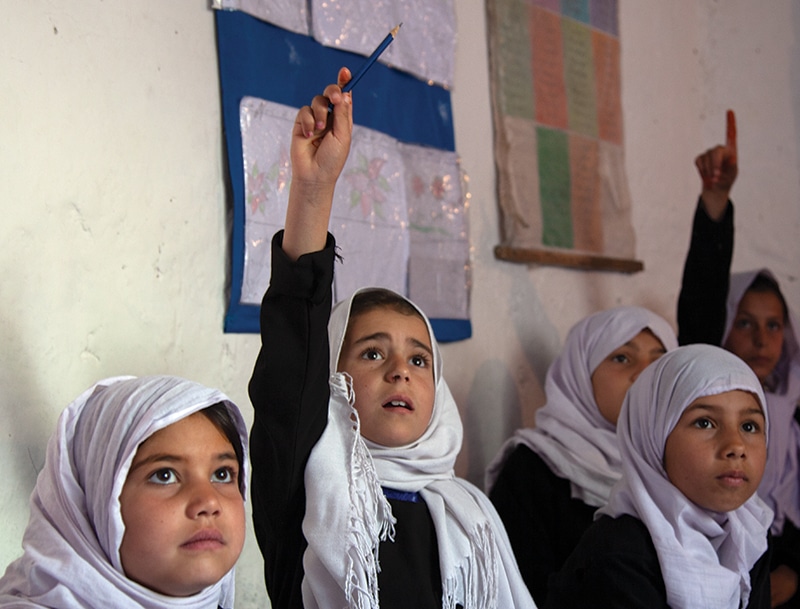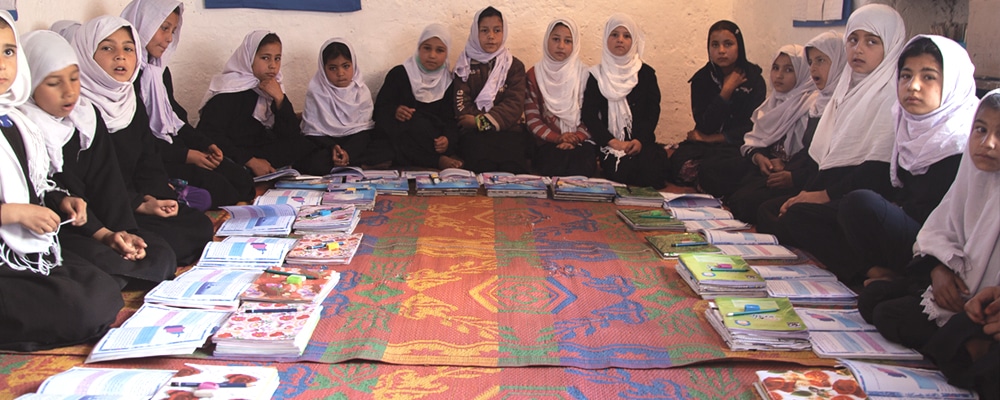Girls’ Education: Finding a way forward under Taliban rule
By Molly Shapiro
Afghanistan’s recent fall to the Taliban has brought global attention to the immense challenges girls and women living in conservative cultures face in accessing education. While there have been enormous gains in female education in Afghanistan since the U.S.-led incursion in 2001,
millions of female students around the country may be forced to drop out of school or banned from attending should the Taliban move forward in imposing its strict interpretation of Islam.
The situation is even more fraught for girls in rural areas. Even during the 20 years of progress in girls’ education, gains were confined primarily to cities. Until the Taliban seized control in mid-August, 45% of girls in urban areas attended secondary school. In remote, rural areas that tend to lean more conservative, only 17% of girls advanced to secondary school.
For the past 20 years, Central Asia Institute’s programs have focused primarily on remote communities located miles and mountains away from more cosmopolitan urban centers. There, government schools are few and far between, and often out of reach for girls and boys alike. Even where education is available, antiquated attitudes towards the role of women and girls as confined to domestic responsibilities such as doing chores and rearing children have prevailed over centuries. Strict interpretations of Islam that require girls and boys to be separated from one another past the age of 12 also persist. These beliefs have made it much more challenging for girls living in remote, conservative areas to receive an education.
For CAI, working in these remote, conservative areas means that we and our partners have had to learn to bridge the cultural divide and implement strategies for making girls’ education possible.
Locating education in the heart of the community
One of the biggest challenges in educating girls and boys in the remote, mountainous regions of Afghanistan is that there are few formal government schools located nearby. This means that children have to travel long distances to attend classes, which creates a unique barrier for girls living in conservative cultures. Girls must be accompanied by a male relative and cannot travel alone in public. In addition, their parents understandably worry about the dangers their daughters might confront on the road. And poor families with few resources to educate all of their children often favor boys over girls when it comes to who has the privilege of going to school.
Community-based education (CBE) is designed to solve these problems. CBE involves setting up a classroom in the heart of the community, such as in the home of the teacher or another member of the community or in a local building or mosque. Girls’ parents are far more comfortable enrolling them in classes that are more private and located right in the village where students live. It is no surprise that CBE has proven to be one of the most effective strategies for educating girls in Afghanistan over the past 20 years.

Working with the community to gain trust and acceptance
Setting up informal education opportunities to reach remote communities also requires gaining the trust and acceptance of community members. Mustafa, the deputy director of one of CAI’s partner organizations in Afghanistan, explains the intensive groundwork that must be done to engage with conservative communities that are resistant to establishing a school for girls. “We ask the community to be involved in the process and provide space in the village. We recruit teachers from the village. We establish a village council, or shura, to oversee the school. We go to the religious people to explain the importance of education for girls.”
Given the disproportionately low school enrollment rate among girls, especially in rural areas, as well as the difficulties for girls to access formal schools, CAI and its partners prioritize educational programs for girls. According to Mustafa, communities question this emphasis on girls’ education. And they often push back on the notion of hiring female teachers, saying they should not be hired over a male teacher and should instead remain in the home. “So we talk with the village elders and convince those people to let the females be involved in our project,” he explains.
Most importantly, Mustafa and his colleagues emphasize that the community has real ownership of their school. “We tell them that this program is for you and for your children,” he says. “You should monitor this program. You should monitor if our organization properly provides services to your children.”
Sometimes Mustafa and his team point to other nearby villages that have experienced the benefits of girls’ education. Or they’ll try to show that educating girls does not go against the community’s culture, customs, or religion. In the end, most villages do embrace CBE, and only in rare circumstances has the team had to give up and move on to another village.
Finding a way forward under Taliban rule
Of course with the Taliban back in control of the government, the advances made in girls’ education are in serious jeopardy. Under the group’s strict interpretation of Islam, high school and university-level female students face far greater restrictions on their right to attend school, and possibly risk being banned from school altogether. But CAI and its partners, having worked in conservative areas over the last two decades, have learned to find a way forward that we hope will prove successful in combating new restrictions.
For example, when Mustafa learned that the head of education for the Taliban wanted to shut down a computer class for teenage girls in Nangarhar province, he went to the man’s office and convinced him to allow the class to continue. He and his team have also worked strenuously to encourage the village shuras (councils) to keep their community-based schools open—and they have. In fact, for some communities, the more the Taliban restricts girls’ education, the more they want to create these schools.
There is no telling exactly how far things will go. Yet CAI and its partners, having learned over the past two decades to bridge the cultural divide in conservative areas, remain hopeful. Besides the huge increases in the number of Afghan girls and women who have been educated over the past 20 years, one of the most notable changes in Afghanistan has been the attitude towards education. In 2019, 87% of Afghans surveyed were in favor of girls’ education, according to The Asia Foundation. This is no surprise given the value that educated females bring to their families and communities in terms of improved health, income, and quality of life. While the Taliban leadership may hope to turn back the clock, the changes in attitudes won’t be easy to reverse. This is cause for hope.
*Names have been changed out of concern for people’s safety.







4 responses to “Girls’ Education: Finding a way forward under Taliban rule”
Calendars this year?
Yes! CAI calendars are back by popular demand. There is a link to the order form at the top of our website or you can email us and we’ll make sure you’re taken care of – info@centralasiainstitute.org. I hope you enjoy it!
Thank you for the forthright information.
You’re very welcome, Sandy. We’ll do our best to keep you updated as things evolve.